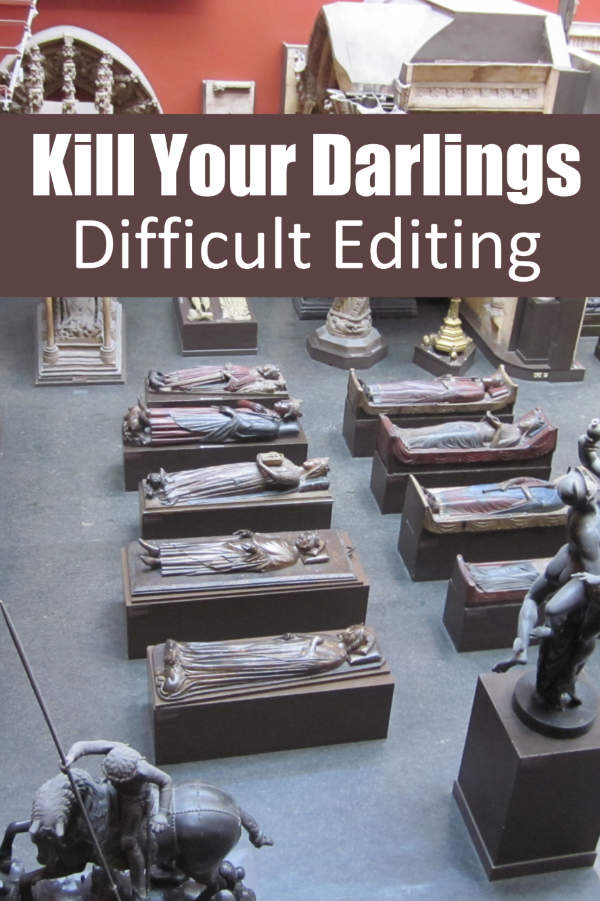“Kill your darlings” is a phrase familiar to most writers. The phrase is often attributed to Stephen King who said, “Kill your darlings, kill your darlings, even when it breaks your egocentric little scribbler’s heart, kill your darlings.” He was actually quoting William Faulkner who said, “In writing, you must kill all your darlings.”
The phrase is a warning to writers about holding on to their favourite bits of prose or poetry even when the story or poem may be better off without them. Elements that hold special meaning to the writer may be of no interest to the reader and may actually detract from the piece.
How does something in one’s writing become a darling in the first place? I don’t have the complete answer to this, but I can identify a couple of ways in which this might happen. If you’ve come up with a particularly beautiful phrase, sentence, or description, you want readers to see it and appreciate your eloquence. A “darling” might be an event, background information, a character trait, or a piece of great interest to the writer but of no relevance to the story. If that eloquent phrasing, trait, or event had to be shoehorned into the piece in the first place or you need to put your story through contortions to keep it in, it probably needs to go.
Often writers do not realize we’re treating something as a “darling.” We become attached to a plot element, character action, or scene setting we’ve created and cannot imagine the story without it, even when we need to create unnatural scenarios around these elements. We lose sight of the original purpose for that story element.
Although I’ve always thought I was relatively free of “darling” attachments, I recently came face to face with two situations where my “darlings” were causing problems.
The first was with a mystery story, a piece I’m getting back to working on after taking a couple of years break from it. My focus since getting back to it has been on cleaning up the plot. My writing group pointed out some credibility issues with early scenes. I adjusted to incorporate elements to make the situation and character’s actions more credible, but I did not consider removing the scenes or fundamentally altering the course of events. After the changes, I would go a little further in the story and hit another wall of implausibility. There is only so far a reader can suspend disbelief, but I still tried to plow through.
I only began to look seriously at removing the situation causing the credibility issues when I tried to fill in worksheets from a mystery-writing workshop. I was forced to question the reason for the sequence of events I’d created and why I wanted things to unfold in a certain way. After recognizing the story did not need to happen in the exact manner I’d fashioned to date, I was free to brainstorm other character actions and scenarios. Although I haven’t yet fully mapped out the revised plot, I can see a stronger narrative and more compelling characters coming out of the changes.
My second face-to-face with getting rid of darlings related to a couple of travel narratives I’ve been working on. This time it was a webinar on story arc which gave me my aha moment. I was trying to cram too many details into the story. These were details not relevant to the story theme. There were things I’d found interesting about the locale and wanted to share. I need to go back to the pieces and select the details more judiciously. I will likely find it hard to cut these darlings out. I love all these details.
There is a longer-term lesson here for me. I hope it is one I remember, particularly when I struggle to fit the pieces of a plot together or find that the story doesn’t flow. I need to continually question each story element. What is its purpose in the story? Does it need to be there?
How do you deal with your darlings?


Interestingly, I find this happens with painting, too. Some element or technique that I actually love or turned out well does not complement the main focus, but rather, detracts from it. I have to remind myself to continually check the composition or design. And also to remember if I didn’t need that particular element, I can use it another time. The process is all part of learning.
I watched The Room this past weekend in preparation for seeing James Franco’s new movie The Disaster Artist. So many darlings needed to be killed in that script, but it’s fun to watch as an example of all of the amateur mistakes an artist can make.